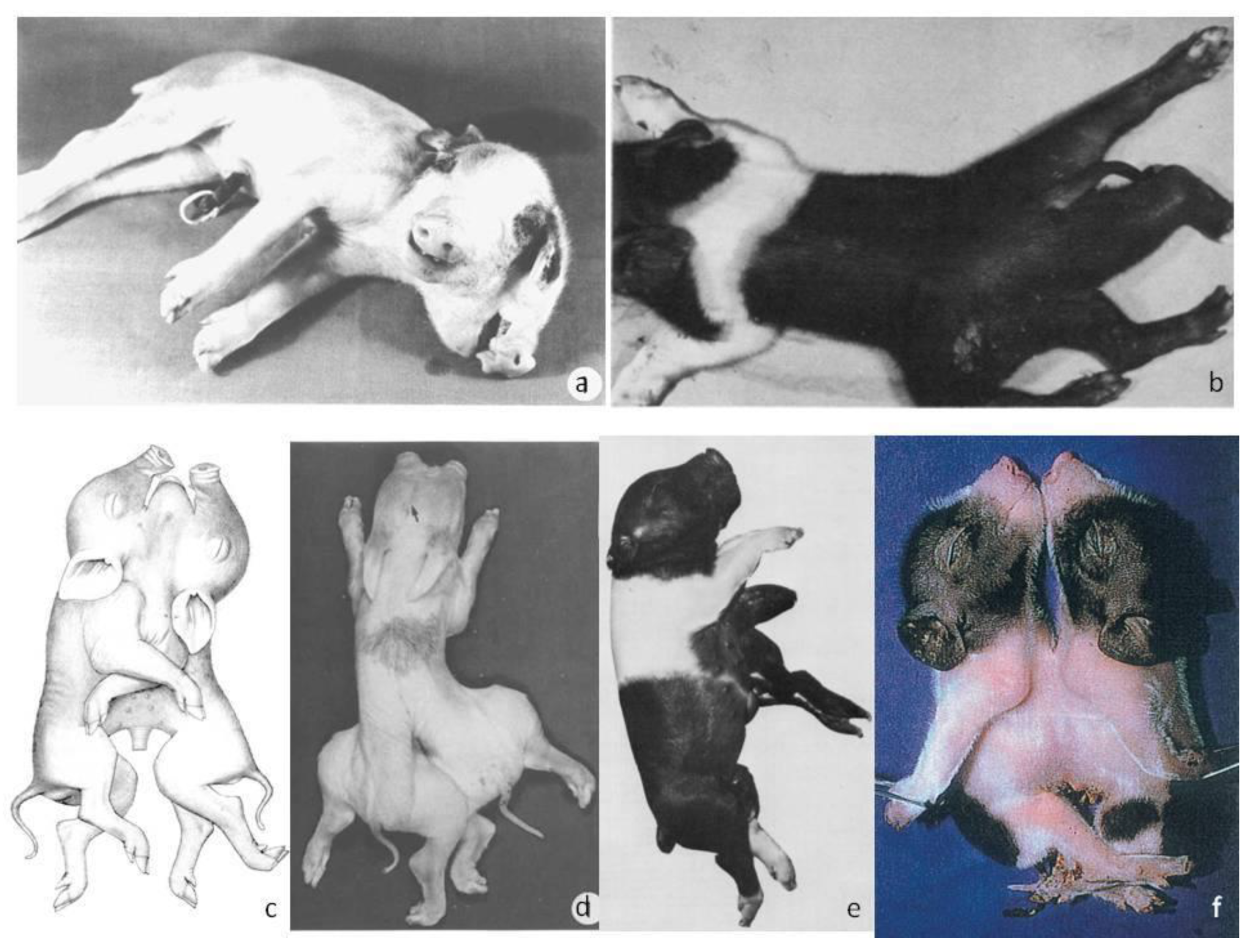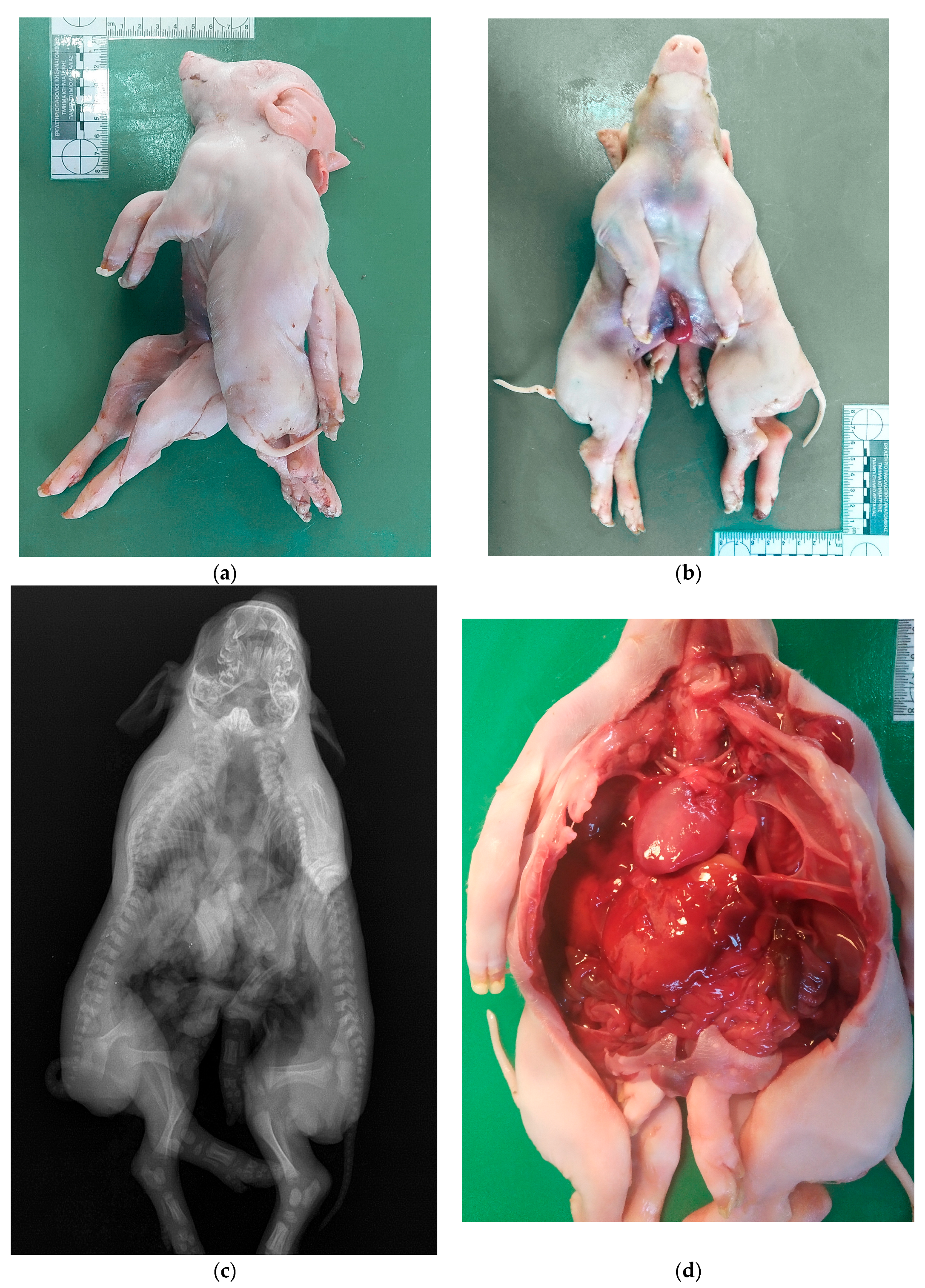Overview of Swine Congenital Malformations Associated with Abnormal Twinning
Abstract
Simple Summary
Abstract
1. Introduction
2. Conjoined Twins
2.1. Diprosopus
2.2. Dicephalus
2.3. Syncephalus Thoracopagus or Cephalothoracopagus
2.4. Our Case
- Two separated spinal cords (one per each vertebral canal);
- A single oral cavity with a single esophagus ending up in a common stomach;
- A common abdominal cavity;
- A common duodenum dividing into a Y shape, creating two separated jejunum tubes;
- A single liver and a single pancreas;
- A single larynx with a single trachea ending up in two bronchi;
- Separated lungs (one lung per bronchus);
- A single enlarged heart (Figure 3d).
2.5. Thoraco-Omphalopagus
3. Free Monozygotic and Parasitic Twins
4. Discussion
5. Conclusions
Author Contributions
Funding
Institutional Review Board Statement
Informed Consent Statement
Data Availability Statement
Acknowledgments
Conflicts of Interest
References
- Arthur, G.H. Conjoined twins—The veterinary aspect. Vet. Rec. 1956, 68, 389–393. [Google Scholar]
- Hiraga, T.; Dennis, S.M. Congenital duplication. Vet. Clin. N. Am. Food Anim. Pract. 1993, 9, 145–161. [Google Scholar] [CrossRef]
- International Committee on Veterinary Embryological Nomenclature [I.C.V.E.N.]. Nomina Embryologica Veterinaria, 2nd ed.; ICVEN: Ghent, Belgium, 2017. [Google Scholar]
- Tejml, P.; Navratil, V.; Zabransky, L.; Soch, M. Conjoined twins in guinea pigs: A case report. Animals 2022, 12, 1904. [Google Scholar] [CrossRef]
- Wilder, H.H. The morphology of cosmobia; speculations concerning the significance of certain types of monsters. Am. J. Anat. 1908, 8, 355–440. [Google Scholar] [CrossRef]
- Bishop, M. Heart and anterior arteries in monsters of the dicephalus group; a comparative study of cosmobia. Am. J. Anat. 1908, 8, 441–472. [Google Scholar] [CrossRef]
- Thuringer, J.M. The anatomy of a dicephalic pig, monosomus diprosopus. Anat. Rec. 1919, 15, 359–367. [Google Scholar] [CrossRef]
- McManus, C.A.; Partlow, G.D.; Fisher, K.P.S. Conjoined twin piglets with duplicated cranial and caudal axes. Anat. Rec. 1994, 239, 224–229. [Google Scholar] [CrossRef] [PubMed]
- Partlow, G.D.; Barrales, D.E.; Fisher, K.P.S. Morphology of a two-headed piglet. Anat. Rec. 1981, 199, 441–448. [Google Scholar] [CrossRef]
- Selby, L.A.; Khalili, A.; Stewart, R.W.; Edmonds, L.D.; Marienfeld, C.J. Pathology and epidemiology of conjoined twinning in swine. Teratology 1973, 8, 1–10. [Google Scholar] [CrossRef]
- Glaser, H. Über die cephalothoracopagen und einen prosopothoracopagus disymmetros vom schwein. Roux Arch. Dev. Biol. 1928, 113, 601–639. [Google Scholar] [CrossRef]
- Mostafa, M.B.; Koma, K.L.M.K.; Acon, J. Conjoined twin piglets. Vet. Rec. 2005, 156, 779–780. [Google Scholar] [CrossRef] [PubMed]
- Groth, W. Dicephalus beim Scwein. Dtsch. Tierarzlt. Wochenschr. 1964, 71, 407. [Google Scholar]
- Wyman, J. Dissection of a double pig. Boston Med. Surg. J. 1861, 64, 535. [Google Scholar]
- Williams, S.R.; Rauch, R.W. The anatomy of a double pig (syncephalus thoracopagus). Anat. Rec. 1917, 13, 273–280. [Google Scholar] [CrossRef][Green Version]
- Carey, E. The anatomy of a double pig, syncephalus thoracopagus, with especial consideration of the genetic significance of the circulatory apparatus. Anat. Rec. 1917, 12, 177–192. [Google Scholar] [CrossRef]
- Jordan, H.E.; Davis, J.S., Jr.; Blackford, S.D. The operation of a factor of spatial relationship in mammalian development as illustrated by a case of quadruplex larynx and triplicate mandible in a duplicate pig monster. Anat. Rec. 1923, 26, 311–318. [Google Scholar] [CrossRef]
- Hunter, G.W.; Higgins, G.M. The anatomy of an abnormal double monster (Duroq) pig. Anat. Rec. 1923, 24, 389. [Google Scholar]
- Baumgardner, W.J. A double monster pig-cephalothoracopagus monosymmetros. Anat. Rec. 1928, 37, 303–316. [Google Scholar] [CrossRef]
- Nordby, J.E.; Taylor, B.L. A syncephalus thoracopagus monster in swine. Am. Nat. 1928, 62, 34–47. [Google Scholar] [CrossRef]
- Engel, E. Einige cephalothoracopagi bei Säugetieren. Virchows Arch. Pathol. Anat. Physiol. Klin. Med. 1931, 3, 706–722. [Google Scholar] [CrossRef]
- Hetzer, H.O.; Eaton, O.N. A case of conjoined twins in the pig. Anat. Rec. 1943, 87, 53–65. [Google Scholar] [CrossRef]
- Halnan, C.R.E. A cephalothoracopagus pig. J. Anat. 1970, 106, 204. [Google Scholar]
- Czarnecki, C.M.; Schenk, K.M.P. A case of monster twinning (cephalothoracopagus) in the pig. Br. Vet. J. 1977, 133, 530–534. [Google Scholar] [CrossRef]
- Kulawik, M.; Pluta, K.; Wojnowska, M.; Bartyzel, B.; Nabzdyk, M.; Bukowska, D. Cephalothoracopagus (monocephalic dithoracic) conjoined twins in a pig (Sus scrofa f. domesticus): A case report. Vet. Med. 2017, 62, 470–477. [Google Scholar] [CrossRef]
- Lloyd Jones, T. Two anomalies in swine. Can. J. Comp. Med. Vet. Sci. 1945, 9, 287. [Google Scholar]
- Baumgardner, W.J.; Everham, B. A double monster pig-Thoracopagus Disymmetros. Trans. Kansas Acad. Sci. 1936, 39, 251–255. [Google Scholar] [CrossRef]
- O’Donoghue, J.G. Conjoined twin pigs. Can. J. Comp. Med. 1951, 15, 96–97. [Google Scholar] [PubMed]
- Schmincke, A. Vergleichende untersuchungen über die anlage des skelettsystems in tierischen mißbildungen mit einem beitrag zur makro- und mikroskopischen anatomie derselben. Virchows Arch. Pathol. Anat. Physiol. Klin. Med. 1921, 230, 564–607. [Google Scholar] [CrossRef]
- Spencer, R. Theoretical and analytical embryology of conjoined twins. Part I: Embryogenesis. Clin. Anat. 2000, 13, 36–53. [Google Scholar] [CrossRef]
- Spencer, R. Theoretical and analytical embryology of conjoined twins. Part II: Adjustments to union. Clin. Anat. 2000, 13, 97–120. [Google Scholar] [CrossRef]
- Selby, L.A.; Hopps, H.C.; Edmonds, L.D. Comparative aspects of congenital malformations in man and swine. J. Am. Vet. Med. Assoc. 1971, 159, 1485–1490. [Google Scholar] [PubMed]
- Bille, N.; Nielsen, N.C. Congenital malformations in pigs in a post mortem material. Nord. Vet. Med. 1977, 29, 128–136. [Google Scholar] [PubMed]



| Geminus acardiacus | |||
| Defectio cordis | |||
| totalis | |||
| subtotalis | |||
| Gemini conjuncti | |||
| Gemini symmetrici | |||
| Junctio cranialis | |||
| dorsalis | |||
| lateralis | |||
| ventralis | |||
| Junctio media | |||
| xiphoidea | |||
| sternalis | |||
| thoracica | |||
| thoraco-epigastrica | |||
| Junctio caudalis | |||
| dorsalis | |||
| lateralis | |||
| ventralis | |||
| Gemini asymmetrici | |||
| Junctio cranialis | cranialis parasitica | ||
| gnathialis parasitica | |||
| Junctio media | |||
| thoraco-epigastrica parasitica | |||
| abdominalis parasitica | |||
| Junctio caudalis | |||
| pygalis parasitica |
| Classification | Brief Description | References |
|---|---|---|
| Syncephalus thoracopagus |
| Wyman 1861 [14] |
| Wilder 1908 [5] | |
| Williams and Rauch 1917 [15] | |
| Syncephalus thoracopagus |
| Carey 1917 [16] |
| Jordan et al. 1923 [17] | |
| Hunter and Higgins 1923 [18] | |
| Cephalothoracopagus monosymmetros |
| Baumgardner 1928 [19] |
| Syncephalus thoracopagus | Nordby and Taylor 1928 [20] | |
| Cephalothoracopagus monosymmetros tetrophthalmus synotos tetrabrachius |
| Glaser 1928 [11] |
| Glaser 1928 [11] | |
| Cephalothoracopagus monosymmetros synotos tetrabrachius |
| Glaser 1928 [11] |
| Glaser 1928 [11] | |
| Glaser 1928 [11] | |
| Glaser 1928 [11] | |
| Cephalothoracopagus monosymmetros biauritus tetrabrachius |
| Glaser 1928 [11] |
| Glaser 1928 [11] | |
| Glaser 1928 [11] | |
| Cephalothoracopagus monosymmetros synotos tetrabrachius cranii e latere coalitis |
| Glaser 1928 [11] |
| Prosopothoracopagus disymmetros |
| Glaser 1928 [11] |
| Cephalothoracopagus monosymmetros |
| Engel 1931 [21] |
| Engel 1931 [21] | |
| Cephalothoracopagus |
| Hetzer and Eaton 1943 [22] |
| Halnan 1970 [23] | |
| Czarnecki and Schenk 1977 [24] | |
| Cephalothoracopagus monocephalic dithoracic |
| Kulawik et al. 2017 [25] |
| Prosopothoracopagus |
| Lloyd Jones 1945 [26] |
Disclaimer/Publisher’s Note: The statements, opinions and data contained in all publications are solely those of the individual author(s) and contributor(s) and not of MDPI and/or the editor(s). MDPI and/or the editor(s) disclaim responsibility for any injury to people or property resulting from any ideas, methods, instructions or products referred to in the content. |
© 2023 by the authors. Licensee MDPI, Basel, Switzerland. This article is an open access article distributed under the terms and conditions of the Creative Commons Attribution (CC BY) license (https://creativecommons.org/licenses/by/4.0/).
Share and Cite
Pourlis, A.; Papakonstantinou, G.I.; Doukas, D.; Papatsiros, V.G. Overview of Swine Congenital Malformations Associated with Abnormal Twinning. Vet. Sci. 2023, 10, 534. https://doi.org/10.3390/vetsci10090534
Pourlis A, Papakonstantinou GI, Doukas D, Papatsiros VG. Overview of Swine Congenital Malformations Associated with Abnormal Twinning. Veterinary Sciences. 2023; 10(9):534. https://doi.org/10.3390/vetsci10090534
Chicago/Turabian StylePourlis, Aris, Georgios I. Papakonstantinou, Dimitrios Doukas, and Vasileios G. Papatsiros. 2023. "Overview of Swine Congenital Malformations Associated with Abnormal Twinning" Veterinary Sciences 10, no. 9: 534. https://doi.org/10.3390/vetsci10090534
APA StylePourlis, A., Papakonstantinou, G. I., Doukas, D., & Papatsiros, V. G. (2023). Overview of Swine Congenital Malformations Associated with Abnormal Twinning. Veterinary Sciences, 10(9), 534. https://doi.org/10.3390/vetsci10090534








